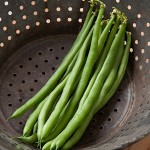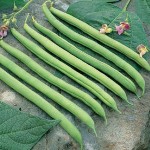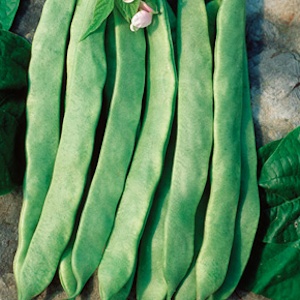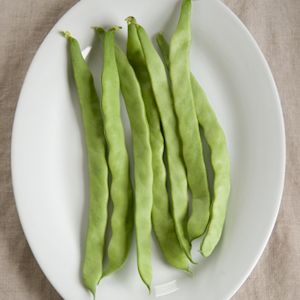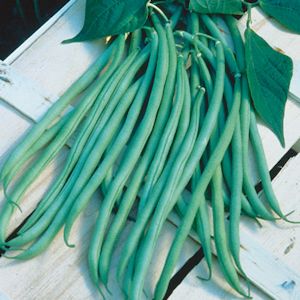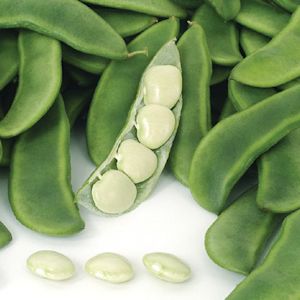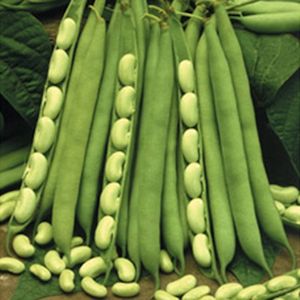Better Beans
All of the pea and bean seeds that we 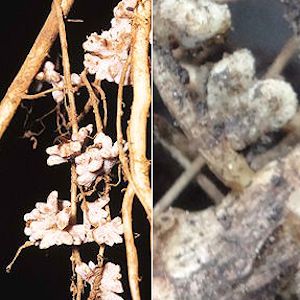 sell have been inoculated with Rhizobia bacteria. These bacteria live in small root nodules found on legume plant roots (see our pea roots in pic on right). They pull (or fix) nitrogen out of the air and provide it to legume plants (like peas, beans, and clover). In return, the plants feed and house the bacterial colonies within these nodules. Studies are starting to show they have benefits beyond just nitrogen fixing — they make plants healthier and more productive.
sell have been inoculated with Rhizobia bacteria. These bacteria live in small root nodules found on legume plant roots (see our pea roots in pic on right). They pull (or fix) nitrogen out of the air and provide it to legume plants (like peas, beans, and clover). In return, the plants feed and house the bacterial colonies within these nodules. Studies are starting to show they have benefits beyond just nitrogen fixing — they make plants healthier and more productive.
We feel using inoculant is important enough that we inoculate our legume seeds for you.These microscopic creatures illustrate our attention to the smallest details that will make your gardening experience more productive — even if it is something you cannot see.
Choose from our selection of specially selected beans for our area. They include bush beans (including round pod, flat pod, and filet), dry beans, lima beans, fava beans, gourmet shell beans, pole beans (including flat pod, round pod, and yard long), and soy beans.
Planting
In general, beans are very sensitive to frost. (The exception is favas, which require a long, cool growing season; sow them at the same time you plant peas.) Most beans grow best in air temperatures of 70° to 80°F, and soil temperature should be at least 60°F. Soggy, cold soil will cause the seeds to rot. Beans need a sunny, well-drained area rich in organic matter. Lighten heavy soils with extra mature compost (min 1-inch) to help seedlings emerge.
If you plant in an area where beans haven’t grown beans or peas recently, help ensure that your bean crop will fix nitrogen in the soil by dusting the seeds with a bacterial inoculant powder for beans and peas (all of our pea and bean seeds are inoculated).
Growing guidelines
Bush beans germinate in about 7 days, pole beans in about 14. It’s important to maintain even soil moisture during this period and also when the plants are about to blossom. If the soil dries out at these times, your harvest may be drastically reduced. Water deeply at least once a week when there is no rain, being careful not to hose off any of the blossoms on bush beans when you water. Apply a couple inches of mulch (after the seedlings emerge) to conserve moisture, reduce weeds, and keep the soil cool during hot spells (high heat can cause blossoms to drop off).
To speed up growth and increase productivity — especially with long-bearing pole beans or heavy-feeding limas — fertilize regularly and apply midseason side-dressing of compost or kelp extract solution.
Planting Bush beans
Dig a trench about 1” deep and 4” wide. Plant seeds about 1½” deep and 2 to 4” apart. Firm the earth over them to ensure soil contact.
Thin bush beans to 4 inches apart. Wide double rows (two parallel rows of beans planted 12 to 14 inches apart) are the most space-efficient way to grow bush beans. These double rows should be spaced 2 to 2½ feet apart. You can put a few brushy sticks or small bamboo stakes in (at planting) vertically every 18-24 inches to hold the row up and off the ground. Or, tie a strong cord around stakes set at the row ends or in each corner of the bed.
Plant your first crop of beans a week or two after the date of the last expected frost.
Remember most varieties produce the bulk of their crop over a 2-week period. For a continuous harvest, stagger plantings at 2-week intervals until about Aug 1 here.
Planting Pole beans
Pole beans are even more sensitive to cold than bush beans. They also take longer to mature (10 to 11 weeks), but they produce about three times the yield of bush beans in the same garden space and keep on bearing longer – and are easier to harvest.
For planting pole beans, dig a trench about 1” deep and 4-6” wide. Plant seeds about 1½” deep and 2 to 4” apart. Firm the earth over them to ensure soil contact. Thin to 4-6” apart.
Provide a trellis or other vertical support at planting or as soon as the first two leaves of the seedlings open. Planting pole beans around a tepee support is a fun project to try if you’re gardening with children, but it will be more difficult to harvest the beans than from a simple vertical trellis.
Problems
Insect pests that attack beans can include aphids, spider mites, caterpillars, slugs, and beetles. The most destructive of all is the Mexican bean beetles.
To minimize problems, grow healthier plants with better soil preparation and fertility — buy disease-free seeds and disease-resistant cultivars, rotate bean crops every one or two years, and space plants far enough apart to provide airflow. Don’t harvest or cultivate beans when the foliage is wet, or you may spread disease spores.
If disease strikes, destroy infested plants immediately, don’t touch other plants with unwashed hands or clippers, and don’t sow beans in that area again for 3 to 5 years.
Harvesting
Pick green beans when they are pencil size, tender, and before the seeds inside form bumps on the pod. Harvest almost daily to encourage production; if you allow pods to ripen fully, the plants will stop producing and die. Pulling directly on the pods may uproot the plants. Instead, pinch off bush beans using your thumbnail and fingers; use scissors on pole and runner beans. Also cut off and discard any overly mature beans you missed in previous pickings. Serve, freeze, can, or pickle the beans the day you harvest them to preserve the fresh, delicious, homegrown flavor.
One of those simple-yet-gourmet foods rarely seen in markets or restaurants, the rewards of fresh shell beans usually belong only to those who grow their own. Pick shell beans for fresh eating when the pods are plump but still tender. Prepared like lima beans, fresh shell beans are much easier to grow and shell. As with most beans, the more you pick, the more the vines will produce. Consume or preserve them as soon as possible. Unshelled, both they and green beans will keep for up to a week in the refrigerator.
To harvest dried beans, leave the pods on the plants until they are brown and the seeds rattle inside them. Seeds should be so hard you can barely dent them with your teeth. If the pods have yellowed and a rainy spell is forecast, cut the plants off near the ground and hang them upside down indoors to dry. To shell dried beans, rub the pods between your hands and into a container with a fan blowing on them. The heavier seeds will fall straight down and the fan will blow away the shells.
Put the shelled beans in airtight, lidded containers. Add a packet of dried milk to absorb moisture, and store the beans in a cool, dry place. They will keep for 10 to 12 months.
Canterbury Creek Gardens bean varieties
Jade
Highest quality bean for gourmet markets. Jade’s beautiful, 6-7″ long, slender, deep green pods are exceptionally tender and delicious. Large, upright plants are heat tolerant and produce heavy second early yields.
Provider
The most popular and dependable early green bean. 5-5 1/2″ long, medium green, fleshy, round pods. The compact plants yield well despite adverse weather.
Container green bush bean
The first AAS winning bean since 1991, this compact variety is perfect for today’s small-space gardens. Mascotte is a bush type bean that produces long, slender pods that stay above the foliage for easy harvest. This bean also has white showy flowers for ornamental value during bloom time. Judges appreciated the crunchiness and taste of this bean as well as the plentiful `1harvest all season long. The Mascotte root system is ideal for patio containers and window 1boxes.
Carson
High yielding and flavorful. Carson’s fancy, slim pods average 5 1/2″ and are flavorful and tender. Plants are vigorous and productive.
Jumbo
Giant, Italian-style green beans. A cross between Romano and Kentucky Wonder, Jumbo has dark green, extra-long pods with rich, bean flavor. While the beans are normally picked at 6-7″, they are still stringless at over 10″
Northeaster
Early maturing, Roma-type pole bean with a deliciously rich, sweet flavor. The 8″ long, 1″ wide, flat green pods are stringless and stay tender for long periods. Vigorous with strong vine growth. Organically grown.
Round Green Pole bean
Gourmet beans growing to over 11″, Fortex produces extra long, round pods over an extended harvest period. Early and very productive, the beans may be picked at 7″ in length for extra slender, “filet” beans. Dark green, firm-textured pods are completely stringless and delicious at all lengths, even after the seeds enlarge.
Speckled Pole Beans
“HEIRLOOM — Exceptional flavor fresh, shelled or dry! Picked fresh, beans are round and dark green with unusual purple streaks. Streaks fade when cooked. Shelled beans are beige, and when dry are tan with rattlesnake streaks. Vines can reach up to 10’ tall with 7-10″” pods when mature.”
Red Noodle
Beautiful dark burgundy pods.High yields of 16-20″ long beans, borne in clusters of up to four beans each. Healthy, vigorous plants. Sweet flavor.
Fordhook Lima bean
Classic, big, plump limas. Early bearing and delicious, this is the best large-seeded variety. Widely adapted.
Fava shell beans
Windsor Fava Bean
Classic English variety. 5-6″ pods each contain 3-5 large, 1″, fresh green shell beans. Pick for green shelling when beans are plump inside the large pods.
Flagrano
French flageolet beans. Flagrano’s pods contain 8-10 mint green seeds which, like peas, are very easy to shell by hand. Often called the “Rolls Royce®” of beans, this pale-green bean with a sublimely subtle flavor is an essential element in French/Mediterranean cuisine.

